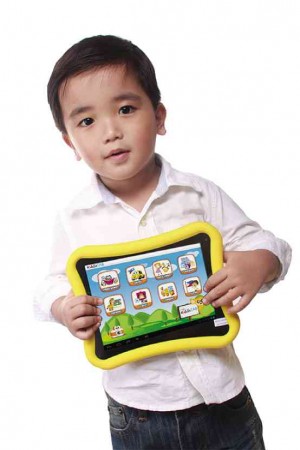A tablet designed for kids and step-ladder learning
Between a deck of flash cards and a tablet with a flash-card app, which one do you think a kid will choose?
Sofia Catindig, 4, picked up the tablet and swiped away, calling out the name of each item on the screen.
“Carrot, mango, tomato, elephant,” she said, as her mom Roan supervised.
Making learning fun keeps the young interested. And what could be more fun to today’s kids, described by scholar Marc Prensky as “digital natives” (born during or after the introduction of technology), than smart gadgets?
Roan said her children were more inclined to learn through apps (applications) in their tablets.
Educational apps, like Sofia’s favorite flash card, are readily available, usually as fun, interactive games. Some introduce children to numbers, language and reading while others let them identify shapes, draw and color.
Tech enhances learning
“They have shown greater gains in intelligence, structural knowledge and problem solving and language skills compared to those who do not use technology as they learn,” psychiatrist Angela Halili-Jao said at the launch of the Enlight Kiddie Tab, the first Android educational tablet in the local market.
Jao said no child was too young for technology. Early exposure to electronic gadgets gives kids basic and vital information technology skills needed in a wired world, she said.
Technology and interactive media are here to stay, said Michal Cruz-Ladioray, strategic partnerships head of Kiddie Tab’s creator Lifeware Technology Inc., a Filipino company specializing in consumer electronics for education.
Quoting writer Wesley Adams, Jao said: “The challenge for parents today is how to ensure that youngsters have plenty of time away from the computer to develop their social skills, explore their creativity and learn how to survive without technology.”
Apps and gadgets could never be the only learning tools, she said.
Parents’ fears that early exposure to technology would lead to kids’ “addiction” could be avoided, Jao said, “as long as parents structure their activities and supervise them.”
Irreplaceable parent
“No device has been created or will ever be created to replace the unique role of a loving parent in a child’s development,” Ladioray said.
Lifeware’s Enlight Kiddie Tab was conceptualized and designed by Filipino engineers and developers, said Lifeware director David Cruz III.
It was specifically designed to enhance the developmental learning of children aged 3-8. The 8-inch tab comes with a durable and nontoxic silicon casing made for a kid’s rough-and-tumble play.
After parents have chosen the applications, cartoony interface with relatively large recognizable app icons happily welcome a young user.
Parents can choose from a curated list of more than a hundred preloaded applications. Jao helped Lifeware screen and choose the apps.
Kiddie Tab organizes the apps based on a step-ladder learning design that is age-specific. Games are grouped into three, those suitable for 3-4-year-olds, 5-6 and 7-8.
Apps for each developmental stage focus on five areas: mathematics and logical reasoning; language and literacy; art, music and creativity; Filipino and general knowledge.
“Basically, it (tab) mirrors and supplements the traditional kinder to primary school curriculum to help kids meet or exceed developmental milestones,” Ladioray said.
Adults can also use the Kiddie Tab like a regular tablet.
The tab has two user modes—the child mode loaded with all kiddie applications and the parent mode that makes it just like any other tablet, allowing the user to surf the Internet, log onto social networking sites, etc.
A password is required to switch users so a kid cannot access apps that are not age-appropriate.
Ladioray said the Facebook in her Kiddie Tab at home was in parent mode to make it inaccessible to her 6-year-old son.
A time lock also allows parents to limit the number of hours a child can use the tablet. When the set time expires, the tablet will automatically shut down.
The time lock aims to encourage children to do other things for holistic growth, like working with coloring books or playing with friends and siblings.

















